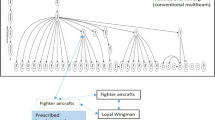Abstract
StarCraft II (SC2) is a real-time strategy science-fiction video game developed by Blizzard Entertainment. Known for its complex state space and open-source environment [8], SC2 has become a popular domain for Artificial Intelligence (AI) research. This paper leverages the advances in AI research from SC2 to build human-autonomy teaming (HAT) aids, AI-driven software tools for human interactivity, for players to improve their skills. The human-machine interface (HMI) that houses these tools breaks the game into different components and visually represents each HAT aid to increase situational awareness and decrease response time.
Access this chapter
Tax calculation will be finalised at checkout
Purchases are for personal use only
Similar content being viewed by others
References
Kiran, R., Thomas, D., Parakkal, R.: An overview of deep learning based methods for unsupervised and semi-supervised anomaly detection in videos (2018). https://arxiv.org/abs/1801.03149
Madumal, P., Miller, T., Sonenberg, L., Vetere, F.: Explainable Reinforcement Learning Through a Causal Lens (2019). https://arxiv.org/pdf/1905.10958.pdf
Synnaeve, G., Lin, Z., Gehring, J., et al.: Forward modeling for partial observation strategy games - a StarCraft defogger. In: Proceedings of the 32nd International Conference on Neural Information Processing Systems (NIPS 2018), pp. 10761–10771. Curran Associates Inc., Red Hook (2018)
Kuan, Y., Wang, Y., Chuang, J.: Visualizing real-time strategy games: the example of StarCraft II. In: 2017 IEEE Conference on Visual Analytics Science and Technology (VAST), pp. 71–80. https://doi.org/10.1109/VAST.2017.8585594
Justesen, N., Risi, S.: Learning macromanagement in StarCraft from replays using deep learning. In: 2017 IEEE Conference on Computational Intelligence in Games (CIG), pp. 162–169. https://arxiv.org/pdf/1707.03743.pdf
Lee, D., Tang H., Zhang, J., et al.: Modular Architecture for StarCraft II with Deep Reinforcement Learning (2018). https://arxiv.org/pdf/1811.03555.pdf
Vinyals, O., Babuschkin, I., Czarnecki, W.M., et al.: Grandmaster level in StarCraft II using multi-agent reinforcement learning. Nature 575, 350–354 (2019). https://doi.org/10.1038/s41586-019-1724-z
StarCraft II Learning Environment. https://github.com/deepmind/pysc2
Blizzard StarCraft II Client. https://github.com/Blizzard/s2client-proto
Ascension to Aiur LE Map. https://liquipedia.net/starcraft2/File:Ascension_to_Aiur_LE.jpg
Author information
Authors and Affiliations
Corresponding author
Editor information
Editors and Affiliations
Rights and permissions
Copyright information
© 2020 Springer Nature Switzerland AG
About this paper
Cite this paper
Izumigawa, C. et al. (2020). Building Human-Autonomy Teaming Aids for Real-Time Strategy Games. In: Fang, X. (eds) HCI in Games. HCII 2020. Lecture Notes in Computer Science(), vol 12211. Springer, Cham. https://doi.org/10.1007/978-3-030-50164-8_8
Download citation
DOI: https://doi.org/10.1007/978-3-030-50164-8_8
Published:
Publisher Name: Springer, Cham
Print ISBN: 978-3-030-50163-1
Online ISBN: 978-3-030-50164-8
eBook Packages: Computer ScienceComputer Science (R0)




